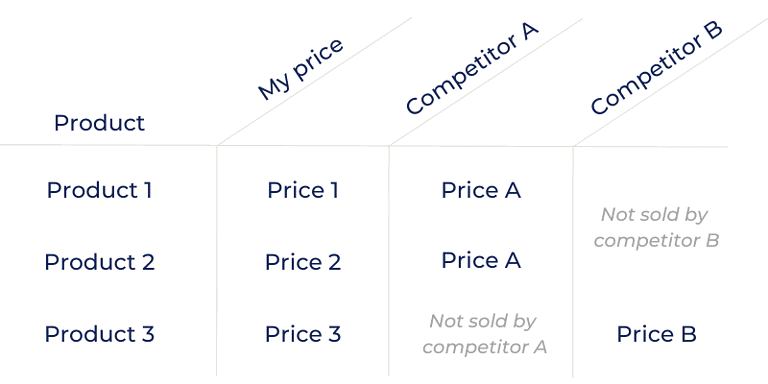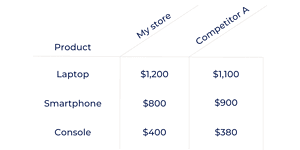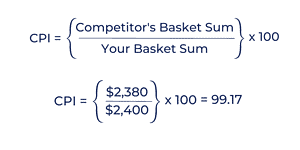In the competitive landscape of pricing strategies, understanding how your prices stack up against your rivals can make all the difference. That’s where the Competitor Price Index (CPI) enters the stage as a powerful Key Performance Indicator (KPI). In this blog post, we’ll delve into the concept of the CPI, its calculation methodology, and how it can revolutionize your approach to pricing.
What is the Competitor Price Index (CPI)?
The Competitor Price Index is a metric that provides insight into how your prices compare to those of your competitors. The CPI represents a sum of prices for products shared between you and your competitors. Your own index value is always set at 100, acting as a benchmark against which your rivals are measured.
Calculating the CPI
To create the CPI, you need to identify the products that you and your competitors have in common. The CPI is determined by summing up the prices of these shared products. Next, compare your basket sum with your competitor’s basket sum and convert this into an index. If the index value is below 100, it indicates that your competitor’s basket is cheaper, while values above 100 mean their basket is more expensive.

Ready to leverage the Competitor Price Index to optimize your pricing strategy? Explore our pricing software solutions and unlock a world of data-driven insights.
Let’s consider a scenario where you run an online electronics store, and one of your main competitors is a well-known retailer in the same industry. To calculate the CPI and assess your pricing performance against this competitor, follow these steps:
Step 1 – Identify Shared Products: Choose a sample of products that both you and your competitor offer. These products should be identical or comparable in terms of brand, model, and specifications. Let’s take three products as an example: a laptop, a smartphone, and a gaming console.
Step 2 – Gather Pricing Data: Collect the prices of the identified products from both your online store and your competitor’s website. Ensure that you are comparing the same variants or models of the products.

Step 3 – Calculate the CPI: To calculate the CPI, sum up the prices of the shared products for both you and your competitor. Then, divide your competitor’s basket sum by your basket sum and convert it to an index.
Your Basket Sum = $1,200 + $800 + $400 = $2,400
Competitor’s Basket Sum = $1,100 + $900 + $380 = $2,380
CPI = (Competitor’s Basket Sum / Your Basket Sum) x 100
CPI = ($2,380 / $2,400) x 100 CPI ≈ 99.17

Step 4 – Interpret the CPI: In this example, the calculated CPI is approximately 99.17. Since the CPI is below 100, it means that the competitor’s basket of shared products is slightly cheaper compared to yours. Specifically, the competitor’s prices are approximately 0.83% lower than your prices on average.
Interpreting the CPI helps you understand how your overall pricing level compares to your competitor. While certain products might be priced higher or lower than your competitor’s offerings, the CPI provides a valuable indicator of your general pricing performance.
By regularly calculating and monitoring the CPI, you can track changes over time, identify pricing trends, and make data-driven decisions to optimize your pricing strategy and maintain a competitive edge.
Remember, the example above showcases a simplified calculation using a small set of shared products. In practice, the CPI can involve a larger number of products, spanning various categories, brands, and competitors.
Unlocking the Benefits of the CPI
- Strategic Pricing Insights: The CPI empowers you to establish pricing guidelines at the company, category, and brand levels. By analyzing the CPI trends over time, you can gain valuable insights into your pricing competitiveness and identify areas for improvement.
- Holistic Performance Monitoring: Rather than fixating on individual product prices, the CPI provides a comprehensive view of your overall pricing performance. It helps you gauge how your pricing strategy fares against your rivals, enabling smarter decisions for optimization.
- Benchmarking and Goal Setting: The CPI acts as a benchmark for your pricing strategy, enabling you to set realistic goals. Whether you aim to be the price leader or maintain a competitive position, the CPI guides you towards achieving the desired market positioning.
- Category and Brand Insights: With the CPI, you can assess your pricing performance within specific categories or brands. Identify opportunities for adjusting your pricing strategies to align with market dynamics and meet consumer expectations.
Conclusion
The Competitor Price Index emerges as a vital KPI to evaluate your pricing performance against competitors. By understanding how your prices compare at the company, category, and brand levels, you can make informed pricing decisions and ensure a competitive edge. Embrace the power of the CPI to guide your pricing strategy, set meaningful goals, and unlock new avenues for growth.


